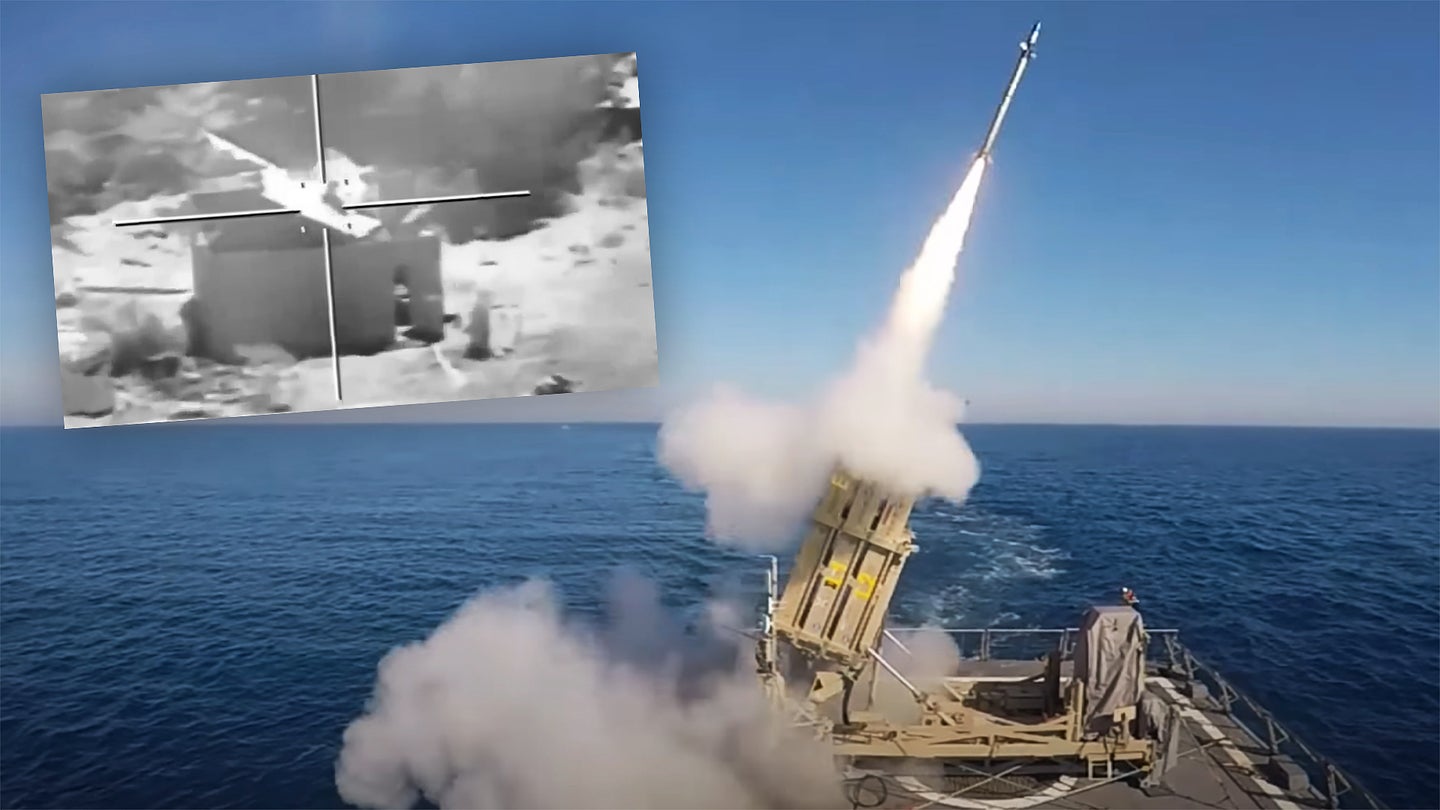Israeli Warships Fire Missiles At Gaza While Hamas Takes Aim At Offshore Oil Platforms
As the Israeli bombardment of Gaza continues, the conflict has now added a maritime dimension.

Reports, as well as video and photos from the Eastern Mediterranean, demonstrate that the Gaza conflict is rapidly expanding into the maritime domain, with Israeli missile strikes now being launched from vessels off the coast against reported Hamas targets in the self-governing Palestinian territory. At the same time, reports from both sides in the conflict confirm that Hamas militants are meanwhile launching rockets against Israeli natural gas platforms in the Mediterranean, which, in turn, are being defended by shipborne Iron Dome air defense systems, and other assets.
With significant overmatch enjoyed by the Israel Defense Forces, or IDF, in the maritime domain, Israeli Navy vessels are now targeting objectives in Gaza using precision-guided missiles launched from the sea. At least one of the publically available videos appears to show the use of a Rafael SPIKE, a familiar precision attack weapon that is also available in navalized form. With an advertised range of almost 20 miles, the Naval SPIKE Non-Line-Of-Sight (NLOS) version can be employed in a “fire and forget” mode or using man-in-the-loop guidance. In the latter mode, the missile can be fired at a specific area and then be manually steered onto the target by an operator who is seeing what the missile sees via a feed from an infrared camera in its nose. In this way, the SPIKE can also be used to reconnoiter targets before striking them, with extreme precision, as well.
While the video below includes many of the hallmarks of SPIKE, the Israeli Navy could potentially also make use of the Israel Aerospace Industries (IAI) Harop for attacks in Gaza. A pioneering suicide drone that is in both Israeli and foreign use, the Harop came to wider prominence after its use in the brief conflict last year between Armenia and Azerbaijan over the contested region of Nagorno-Karabakh. Like the SPIKE, the Harop has also been adapted for maritime use and recently won an order from an undisclosed navy in Asia, as you can read about here.
Israeli reports suggest that, during the first six days of the current campaign in Gaza, the Israeli Navy carried out approximately 100 attacks against Hamas targets, using both missile ships and undisclosed other vessels. This is part of a wider IDF campaign that’s been waged against Gaza, with hundreds of airstrikes that have so far claimed the lives of at least 200 Palestinians.
“The most significant thing, as in all of the IDF, is denying [the enemy] capabilities and establishing a strong defense,” the head of the Israeli Navy Major General Eli Sharvit told the press. “Therefore, we have attacked bases, vessels, weapons warehouses, infrastructure, and operatives. We have acted so that the naval arms of the Palestinian Islamic Jihad and Hamas would be depressed.”
Aside from its offensive operations launched against targets in Gaza, the Israeli Navy is also actively defending the Tamar offshore oilfield. This is located around 50 miles west of the Israeli port of Haifa, and some 14 miles off the coast of Ashkelon, which has borne the brunt of massed rocket attacks, and it lies entirely within Israel’s exclusive economic zone.
At the time of its discovery, in 2009, it was the largest find of gas or oil in the Levant basin of the Eastern Mediterranean. Providing the majority of Israel’s electricity requirements, the importance of these energy reserves is such that the Israeli Navy’s latest Sa’ar 6 class corvettes are widely thought to have been tailored, at least in part, to protecting these installations. The first two vessels in this class are still being outfitted with weapons and other systems.
Much of Israel’s apparent success in defeating the extensive rocket, mortar, and drone attacks it is now facing has been attributed to the Iron Dome air defense system, which you can read about in more detail here. In a ground-based context, the IDF claims that the Iron Dome air defense system has intercepted between 85 and 90 percent of rockets and mortar shells heading toward populated areas in recent days, although that figure could be questionable since Hamas has made concerted efforts to overwhelm the system. As of May 17, 10 people in Israel had been killed in the course of the 3,100 rocket attacks launched from Gaza.
A signal that the natural gas fields of the Eastern Mediterranean were under attack, or at least the imminent threat of attack, came last week when the U.S.-owned Chevron Corporation, a multinational energy concern, said it was temporarily shutting down its operations at the Tamar offshore platform. This followed a statement from the Al Qassam Brigades, the armed wing of Hamas, claiming that they had targeted a “Zionist gas platform” off Gaza.
“Chevron’s top priority is the safety of our personnel, our facilities, and the environment of the communities in which we operate,” a company spokesperson told the Times of Israel.
Although the Israeli Ministry of Energy said the shutdown was not directly related to the statement from Hamas, Chevron, which has an almost 40 percent stake in Tanar, appeared to contradict this, a spokesperson confirming to the same newspaper that the Israeli Ministry of Energy had requested the move.
For its part, the Israeli Ministry of Energy has said it is taking measures to ensure the supply of gas to powerplants continues and that the power supply is not affected. With another gas field, Leviathan, still operational, the energy situation for Israel is not as critical as it was when Tamar was temporarily shut down during fighting in Gaza in 2019 before Leviathan began pumping.
Since the latest Chevron shutdown, the Times of Israel has reported that Hamas has fired “dozens” of rockets toward the Tamar gas rig.
So far, there is no evidence that Hamas has successfully hit the Tamar field although the group has struck other Israeli energy infrastructure, hitting a large oil storage tank in Ashkelon with a rocket, leading to a major blaze. It’s not clear if that incident involved the deliberate targeting of the storage tank, or if it was simply the result of bombardment by unguided rockets.
While there are no figures available about the relative success of the Israeli Navy vessels fitted with Iron Dome that are currently deployed around the Tamar offshore oilfield, Israeli media reports that “none of these rockets came close to striking the rig.”
As well as defending against unguided rockets launched by Hamas, the Iron Dome is also effective against mortar fire and suicide drones — unmanned aerial vehicles carrying explosive warheads, which have also been used in the conflict and are potentially a more suitable weapon with which to target offshore oil infrastructure, since they incorporate some kind of guidance method. These drones share some broad similarities with the Iranian designs that have been employed extensively by the Houthis in Yemen, although they are notably smaller.
Loading up Israeli Navy corvettes with Iron Dome launchers now seems to be a more frequently used tactic, first evidenced by the appearance of the Sa’ar 5 class corvette Lahav armed with two of the launchers earlier this year. On that occasion, the vessel was apparently being prepared to defeat Iranian-supplied suicide drones in the hands of Houthi rebels in Yemen.
Last week, at least one Hamas suicide drone was reportedly downed by an Israeli Air Force F-16 fighter jet operating over the Eastern Mediterranean. There are also reports that at least one Rafael Barak 1 naval point-defense system has been deployed on a platform next to one of the rigs, to provide additional protection. The Barak 1 is primarily intended to defend against aircraft, anti-ship missiles, and drones.
Other potential weapons at the militants’ disposal to attack the oil platforms include “autonomous submarines,” many of which the IDF claims to have already destroyed. Little is known about these weapons, also described as remote-controlled underwater improvised explosive devices, or RC-UWEID. They may even be low-profile or semi-submersible unmanned surface vessels and they reportedly carry a warhead weighing up to 66 pounds. Apparently, at least some of Israel’s coastal missile strikes have been directed against infrastructure supporting these operations.
An official IDF video that purports to show the destruction of an “unmanned diver vehicle,” likely an “autonomous submarine”:
Overall, the risk posed to Israeli offshore energy infrastructure by rockets launched by Hamas is limited; after all, the rigs present physically small targets and are located several miles from the coast. Suicide drones, on the other hand, could be a much more dangerous threat and it’s no surprise that a small armada of warships, plus patrolling fighter jets, have apparently been deployed to counter them. As for the “autonomous submarines” available to Hamas, there is no evidence yet of these having been deployed, but they are clearly a threat that the IDF takes seriously, based on its efforts to eradicate them.
Once again, however, the asymmetric nature of its enemy means that Israel is having to invest considerable resources into defeating a range of threats that are frequently well hidden. This will only become more pronounced as time goes on, by all indications. The large force-protection posture around its oil platforms is another indicator of this.
Contact the author: thomas@thedrive.com
